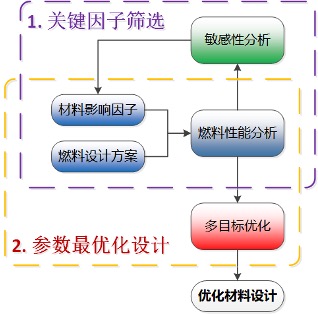Screen and Optimize Material Key
Factors through Fuel Rod Performance Analysis
Wang Shihuai1, Xie Yiran2, Xue Jiaxiang2*,
Li Lei2, Liu Tong1
1 China Nuclear Power Research Institute, Chengdu,
610000, China;
2 China Nuclear Power
Research Institute, Shenzhen, 518000, China;
ABSTRACT: Traditional fuel
performance analysis work is usually applied in the fuel design verification
stage in the engineering field, aimed at optimizing the design of structural
parameters for known design schemes. At this stage, the materials of each
component have been finalized, the material properties have been completed, and
a complete and deterministic material behavior model input is provided for fuel
performance analysis. For new nuclear fuel elements, due to the long R&D
cycle of the materials, the materials are still developing. As a result, a
complete and determinate material performance model cannot be given, but some
models related to material technologies and composition can be provided. Based
on the idea of reverse design, we built a fuel performance analysis tool that
includes input conditions such as material influence factors by implanting
models related to material influence factors which consist of material
technologies and composition into existing fuel analysis models. By use of
DAKOTA, the fuel performance in a reactor was analyzed by a sensitivity
analysis method based on random sampling, and the material factors that have
greater effects on fuel performances could be screened. Furthermore, the
optimized design parameters of materials could be obtained by multi-objective
function optimization of a specific or several in-reactor performances of
current new fuel rod design. By integrating the above processes, a method for
screening and optimizing key factors of new nuclear fuel materials with the
goal of fuel performance optimization was established, and a platform for
search and optimization design of material key factors was developed to realize
the feedback from fuel performance analysis to material design. Based on the
existing fuel material model, a series of material impact factors and property impact
functions were set up and implanted into existing fuel analysis software.
Thereafter, the key factors were screened. To reduce fuel centerline
temperature and rod internal pressure, the parameter optimization design was
carried out. The results show that this method could be used to screen material
key factors, and get the optimal parameter of every factor. With the deepening
of the development of new nuclear fuel materials and the introduction of more
real material property models related to processing technologies and
composition, this method can rapidly feed back to the material development, so
as to obtain an ideal design of new fuel material faster.

Keywords: Material gene; fuel performance analysis; optimal design;

Wang Shihuai completed his master at the age of 24 years in Tsinghua University and is now working at the ATF project department in CNPRI. He is engaged in fuel rod performance analysis and the research of related models and program development. He joined National Science and Technology Major Project: key technology research of accident tolerance fuels, and is a member of the project analysis and evaluation of service behavior of new nuclear fuel components.